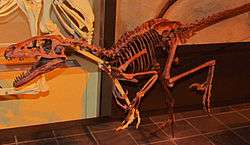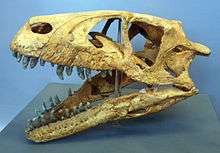Dromaeosaurus
| Dromaeosaurus Temporal range: Late Cretaceous, 76.5–74.8 Ma | |
|---|---|
 | |
| Restored skeleton, Canadian Museum of Nature | |
| Scientific classification | |
| Kingdom: | Animalia |
| Phylum: | Chordata |
| Class: | Reptilia |
| Clade: | Dinosauria |
| Order: | Saurischia |
| Suborder: | Theropoda |
| Family: | †Dromaeosauridae |
| Clade: | †Eudromaeosauria |
| Subfamily: | †Dromaeosaurinae |
| Genus: | †Dromaeosaurus Matthew & Brown, 1922 |
| Type species | |
| †Dromaeosaurus albertensis Matthew & Brown, 1922 | |
| Species | |
| |
Dromaeosaurus (/ˌdroʊmiəˈsɔːrəs, -mioʊ-/,[1] "running lizard") was a genus of theropod dinosaur which lived during the Late Cretaceous period (middle late Campanian), sometime between 76.5 and 74.8 million years ago, in the western United States and Alberta, Canada. The type species is Dromaeosaurus albertensis, which was described by William Diller Matthew and Barnum Brown in 1922.
Description

Dromaeosaurus was a small carnivore, about 2 m (6.6 ft) in length and 15 kg (33 lb) in weight. Its mouth was full of sharp teeth, and it had a sharply curved "sickle claw" on each foot. It lived during the Campanian stage of the Late Cretaceous, however, some fragmentary remains such as teeth which may belong to this genus have been found from the late Maastrichtian age Lance and Hell Creek Formations, dating to 66 million years ago.[2]
Dromaeosaurus had a relatively robust skull with a deep snout. Its teeth were rather large and it had only nine of them in each maxilla.[3] Dromaeosaurus also had a vein at the back of the head, the vena capitis dorsalis, that drained the front neck muscles through two long canals running to the posterior surface of the brain.[4]
History of discovery

Despite receiving widespread attention in popular books on dinosaurs, and the usage of a complete mounted skeleton cast in museums throughout the world, Dromaeosaurus is surprisingly poorly known from actual fossils. The preparation of the popular cast by the Tyrrell Museum was only made possible by knowledge gained from other dromaeosaurids that have been discovered more recently.
The first known Dromaeosaurus remains were discovered by paleontologist Barnum Brown during a 1914 expedition to Red Deer River on behalf of the American Museum of Natural History.[5] The area where these bones were collected is now part of Dinosaur Provincial Park in Alberta, Canada.[3] The find, holotype AMNH 5356, consisted of a partial skull 24 cm (9.4 in) in length, a mandible, two hyoids, a first metacarpal and some foot bones. The skull lacked most of the top of the snout.[3][5] Several other skull fragments, and about thirty isolated teeth, are known from subsequent discoveries in Alberta and Montana.[3]
In 1922 William Diller Matthew and Brown named and described the type species of Dromaeosaurus: Dromaeosaurus albertensis. The generic name is derived from the Greek δρομεύς (dromeus) meaning 'runner' and σαύρος (sauros) meaning 'lizard'. The specific name, "albertensis", refers to Alberta.
Another seven species of Dromaeosaurus were named: Dromaeosaurus laevifrons (Cope 1876) Matthew & Brown 1922; Dromaeosaurus cristatus (Cope 1876) Matthew & Brown 1922 (Troodon); Dromaeosaurus? gracilis (Marsh 1888) Matthew & Brown 1922; Dromaeosaurus explanatus (Cope 1876) Kuhn 1939; Dromaeosaurus minutus (Marsh 1892) Russell 1972 (an alvarezsaurid); Dromaeosaurus falculus (Cope 1876) Olshevsky 1979 and Dromaeosaurus mongoliensis (Barsbold 1983) Paul 1988 (Velociraptor). Most of them were based on fragmentary material, some belonging to other genera, and far less complete than that of Dromaeosaurus albertensis, and those that haven't been reclassified are considered nomina dubia today.[3] Nevertheless, it has grown apparent that Dromaeosaurus albertensis is even rarer in its habitat than other small theropods, although it was the first dromaeosaurid of which reasonably good cranial material was described.[3]
Paleobiology
Dromaeosaurus differs from most of its relatives in having a short, massive skull, a deep mandible, and robust teeth. The teeth tend to be more heavily worn than those of its relative Saurornitholestes, suggesting that its jaws were used for crushing and tearing rather than simply slicing through flesh. Therrien et al. (2005) estimated that Dromaeosaurus had a bite nearly three times as powerful as that of Velociraptor and suggested it relied more on its jaws than on the sickle claw to kill its prey.[6] The discovery of the sister species Dakotaraptor, which has a larger flexor tubercle than most other dromaeosaurs, also supports the suggestion that Dromaeosaurus would have used its sickle claw less than other dromaeosaurids.[7]
Phylogeny
Matthew and Brown originally placed Dromaeosaurus to its own subfamily, the Dromaeosaurinae, within the "Deinodontidae" (now known as Tyrannosauridae) based on some similarities in the general proportions of the skull.[5] In 1969, John H. Ostrom recognized that Dromaeosaurus shared many features with Velociraptor and the newly discovered Deinonychus, and assigned these forms to a new family: Dromaeosauridae.[8] Since then, many new relatives of Dromaeosaurus have been found.
The exact relationships of Dromaeosaurus are somewhat unclear. Although its rugged build gives it a primitive appearance, it was actually a very specialized animal.[9] In analyses of the present clade Dromaeosaurinae species as Utahraptor, Achillobator and Yurgovuchia are often recovered.[10] As of recently, the genus Dakotaraptor has been classified as the sister taxon to Dromaeosaurus.[7]

Below is a cladogram by Senter et al. in 2012. Dromaeosaurus is recovered as the sister taxon to Yurgovuchia, Utahraptor and Achillobator.[10]
| Eudromaeosauria |
| |||||||||||||||||||||||||||||||||||||||
| |
The cladogram below follows a 2015 analysis by paleontologists Robert DePalma, David Burnham, Larry Martin, Peter Larson, and Robert Bakker, using updated data from the Theropod Working Group. In this analysis, Dromaeosaurus is classified as the sister taxon to Dakotaraptor.[7]
| Eudromaeosauria |
| ||||||||||||||||||||||||||||||||||||||||||
| |
See also
Footnotes
- ↑ "Dromaeosaur". Oxford Dictionaries. Oxford University Press. Retrieved 2016-01-21.
- ↑ Weishampel, et al.
- 1 2 3 4 5 6 Currie (1995).
- ↑ "Description," Larsson (2001). Page 23.
- 1 2 3 Matthew and Brown (1922).
- ↑ Therrien, et al. (2005).
- 1 2 3 DePalma, Robert A.; Burnham, David A.; Martin, Larry D.; Larson, Peter L.; Bakker, Robert T. (2015). "The First Giant Raptor (Theropoda: Dromaeosauridae) from the Hell Creek Formation.". Paleontological Contributions (14).
- ↑ Ostrom (1969).
- ↑ Paul (1988).
- 1 2 Senter, P.; Kirkland, J. I.; Deblieux, D. D.; Madsen, S.; Toth, N. (2012). Dodson, Peter, ed. "New Dromaeosaurids (Dinosauria: Theropoda) from the Lower Cretaceous of Utah, and the Evolution of the Dromaeosaurid Tail". PLoS ONE. 7 (5): e36790. doi:10.1371/journal.pone.0036790. PMC 3352940
 . PMID 22615813.
. PMID 22615813.
References
- Currie, Philip J. (1995). "New information on the anatomy and relationships of Dromaeosaurus albertensis (Dinosauria: Theropoda)". Journal of Vertebrate Paleontology. 15 (3): 576–591. doi:10.1080/02724634.1995.10011250.
- Currie, P. J.; Rigby, K. J.; Sloan, Robert E. (1990). "Theropod teeth from the Judith River Formation of southern Alberta, Canada". In Currie, P. J.; Carpenter, K. Dinosaur Systematics: Perspectives and Approaches. Cambridge: Cambridge University Press. pp. 107–125. ISBN 0-521-43810-1.
- Dixon, Dougal (2006). The Illustrated Encyclopedia of Dinosaurs. Lorenz Books. pp. 200–201. ISBN 0-7548-1573-0.
- Larsson, H.C.E. 2001. Endocranial anatomy of Carcharodontosaurus saharicus (Theropoda: Allosauroidea) and its implications for theropod brain evolution. pp. 19–33. In: Mesozoic Vertebrate Life. Ed.s Tanke, D. H., Carpenter, K., Skrepnick, M. W. Indiana University Press.
- Matthew, William D.; Brown, Barnum (1922). "The family Deinodontidae, with notice of a new genus from the Cretaceous of Alberta". Bulletin of the American Museum of Natural History. 46: 367–385. hdl:2246/1300.
- Ostrom, John H. (1969). "Osteology of Deinonychus antirrhopus, an unusual theropod from the Lower Cretaceous of Montana". Peabody Museum of Natural History Bulletin. 30: 1–165.
- Paul, Gregory S. (1988). "The Wonderful and Spectacular Dromaeosaurian Sickle-Claws". Predatory Dinosaurs of the World. Simon & Schuster. pp. 357–370. ISBN 0-671-61946-2.
- Colbert, E.; Russell, D. A. (1969). "The small Cretaceous dinosaur Dromaeosaurus". American Museum Novitates. 2380: 1–49. hdl:2246/2590.
- Therrien, Francois; Henderson, Donald M.; Ruff, Christopher B. (2005). "Bite Me: Biomechanical models of theropod mandibles and implications for feeding". In Carpenter, Kenneth. The Carnivorous Dinosaurs. Life of the Past. Indiana University Press. pp. 179–237. ISBN 0-253-34539-1.
- Weishampel, David B.; Dodson, Peter; and Osmólska, Halszka (eds.): The Dinosauria, 2nd, Berkeley: University of California Press. 861 pp. ISBN 0-520-24209-2.
| Wikimedia Commons has media related to Dromaeosaurus. |

